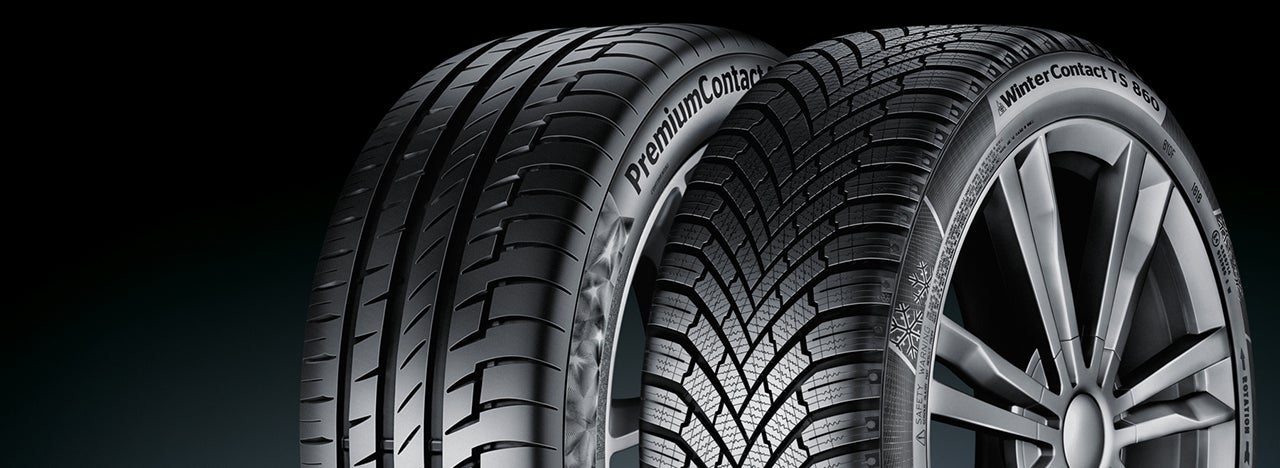
# Tire Change and Fitting
Mixing tires
To mix or not to mix your tires?
In this section, you’ll learn the critical information about mixing tires on your vehicle. Primarily, you should avoid mixing different tire brands and different tread patterns. There are rare exceptions for approved mixed-tire fittings, but in general, manufacturers do not recommend tire mixing at all.
For optimal safety and performance, Continental recommends fitting the same tires to every wheel position on your car, so drivers should have the same brand, size, tread pattern, load index, and speed rating on the front and rear tires.
As a bare minimum, tires must conform to recommendations concerning size, load index, and speed rating as provided by the vehicle manufacturer. It’s a legal requirement in many countries.
Driving a car with a set of mismatched tire sizes, constructions, load indexes, or speed ratings can pose a danger to you and other road users. It’s always best to follow the vehicle manufacturer’s specifications or consult a qualified tire specialist.

The benefits of tire rotation
Rotating tires is a proven strategy to maximize tire service life and tire wear.
The vehicle manufacturer will have custom guidance for the optimal rotation pattern and frequency. The rotation pattern depends on whether you have symmetrical, asymmetrical, or directional tires.

If there are no special considerations, our recommendation is to rotate the wheels axle-wise between the front and the back on a regular basis.
Regarding timing, an excellent opportunity is the seasonal switching between summer tires and winter tires. Alternatively, tire rotation at mileage intervals between 5,000 km and 10,000 km is also effective.
If you notice signs of uneven tire wear, however, consider rotating them even more frequently. And ask your friendly neighborhood tire dealer to check for any wheel misalignment or other mechanical problem. They can make the necessary corrections.
Full-size spare tires of the same size and construction as the regular tires should also feature in your tire rotation. Before incorporating the spare, however, don’t forget to check and adjust its inflation pressure.
Speaking of air pressure, you should also adjust the air pressure according to the vehicle manufacturer’s recommendation for the new wheel position, as the specific pressures for the front tires and rear tires may differ.
Rotated tires can also affect the Tire Pressure Monitoring System (TPMS), if your car is equipped with it. Consult the owner’s manual or a qualified service professional to make the proper adjustments and recalibrate the system.
Can you mix different tire brands and tread patterns on your vehicle?
First and foremost, our guidance is to fit the same tires on all wheel positions of your vehicle.
However, if mixing becomes unavoidable due to a lack of availability or budget constraints, then it’s possible to mix tire brands and tread patterns – but only so long as drivers fit a pair of tires with the same tread patterns and brands across the same axle. That means installing a pair of identical tires on the rear axle, or a pair of identical tires to the front.
It may also be possible to mix tires with different load indexes and speed ratings if the load index and speed symbols are higher than the minimum threshold recommended by the vehicle manufacturer (extra load vs. standard load). In these instances, fit the higher-rated tires to the rear axle.

Mixing tires with different tread depths
If you are replacing only two tires on your vehicle, the new tires will probably have a deeper tread depth than the older tires.
Mixing different tread depths is generally permissible. The tire industry recommends fitting the new tires onto the rear axle. This will provide greater grip to the rear axle and mitigate any potential oversteer condition or loss of vehicle stability on slippery surfaces.
There can be exceptions, however. Some car manufacturers will recommend fitting the new tires to the front axle, for example, if the car is a front-wheel drive. Consult your vehicle manufacturer’s handbook or a tire specialist for further information.
Approved tire mixture
Some vehicles are factory-fitted with tires of different sizes between the rear and front axles. These tire mixtures are specific to the car and will require special considerations when the time comes to replace them. Always follow the recommendations of the vehicle manufacturer.
Related content
-
 2024/10/17Summer tires vs. winter tiresThe weather changes throughout the year, which affects driving conditions on the road; fit your car with tires that will provide you with the most confidence.Read more
2024/10/17Summer tires vs. winter tiresThe weather changes throughout the year, which affects driving conditions on the road; fit your car with tires that will provide you with the most confidence.Read more -
 2024/10/17Winter tires in summerWinter tires are the undisputed champion when it comes to colder climates, but their unique features are a disadvantage if used in warmer temperatures.Read more
2024/10/17Winter tires in summerWinter tires are the undisputed champion when it comes to colder climates, but their unique features are a disadvantage if used in warmer temperatures.Read more -
 2024/10/17Summer tires in winterWinter is a time to put winter tires on your car. We recommend against using summer tires if there's any snow, ice, or the temperature is freezing.Read more
2024/10/17Summer tires in winterWinter is a time to put winter tires on your car. We recommend against using summer tires if there's any snow, ice, or the temperature is freezing.Read more